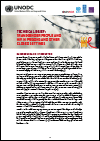Publications on Prisoners

Marked inequalities and diverse epidemic trends affect progress in the HIV response in Asia and the Pacific. The HIV epidemic in the region disproportionately affects people from key populations, especially young people (aged 15–24 years), and their sexual partners. Download the regional factsheet to find out the most up-to-date HIV info, data and analysis.

Transgender people often experience multiple and intersecting forms of discrimination, including in criminal justice systems. Evidence indicates that such marginalisation, criminalisation and discrimination can lead to greater vulnerability to and risk of long-term mental and physical health issues, including increased risk of HIV and other sexually transmitted infections, and experience of sexual assault.

With the dearth of data in many prison systems, Global Prison Trends is pivotal in bringing to light the information that is available to identify and highlight key trends affecting the 11.5 million people in prisons worldwide. Data and information are critical in the global struggles facing societies, especially in managing crises as seen with the COVID-19 pandemic or as conflict breaks out. Data is also vital in challenging exclusion, realising human rights of those most left











